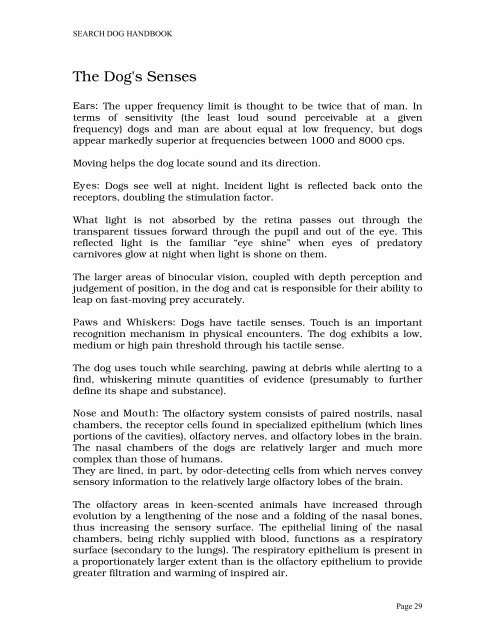Search Dog Handbook - Scott County Search and Rescue K9 Unit
Search Dog Handbook - Scott County Search and Rescue K9 Unit
Search Dog Handbook - Scott County Search and Rescue K9 Unit
You also want an ePaper? Increase the reach of your titles
YUMPU automatically turns print PDFs into web optimized ePapers that Google loves.
SEARCH DOG HANDBOOK<br />
The <strong>Dog</strong>'s Senses<br />
Ears: The upper frequency limit is thought to be twice that of man. In<br />
terms of sensitivity (the least loud sound perceivable at a given<br />
frequency) dogs <strong>and</strong> man are about equal at low frequency, but dogs<br />
appear markedly superior at frequencies between 1000 <strong>and</strong> 8000 cps.<br />
Moving helps the dog locate sound <strong>and</strong> its direction.<br />
Eyes: <strong>Dog</strong>s see well at night. Incident light is reflected back onto the<br />
receptors, doubling the stimulation factor.<br />
What light is not absorbed by the retina passes out through the<br />
transparent tissues forward through the pupil <strong>and</strong> out of the eye. This<br />
reflected light is the familiar “eye shine” when eyes of predatory<br />
carnivores glow at night when light is shone on them.<br />
The larger areas of binocular vision, coupled with depth perception <strong>and</strong><br />
judgement of position, in the dog <strong>and</strong> cat is responsible for their ability to<br />
leap on fast-moving prey accurately.<br />
Paws <strong>and</strong> Whiskers: <strong>Dog</strong>s have tactile senses. Touch is an important<br />
recognition mechanism in physical encounters. The dog exhibits a low,<br />
medium or high pain threshold through his tactile sense.<br />
The dog uses touch while searching, pawing at debris while alerting to a<br />
find, whiskering minute quantities of evidence (presumably to further<br />
define its shape <strong>and</strong> substance).<br />
Nose <strong>and</strong> Mouth: The olfactory system consists of paired nostrils, nasal<br />
chambers, the receptor cells found in specialized epithelium (which lines<br />
portions of the cavities), olfactory nerves, <strong>and</strong> olfactory lobes in the brain.<br />
The nasal chambers of the dogs are relatively larger <strong>and</strong> much more<br />
complex than those of humans.<br />
They are lined, in part, by odor-detecting cells from which nerves convey<br />
sensory information to the relatively large olfactory lobes of the brain.<br />
The olfactory areas in keen-scented animals have increased through<br />
evolution by a lengthening of the nose <strong>and</strong> a folding of the nasal bones,<br />
thus increasing the sensory surface. The epithelial lining of the nasal<br />
chambers, being richly supplied with blood, functions as a respiratory<br />
surface (secondary to the lungs). The respiratory epithelium is present in<br />
a proportionately larger extent than is the olfactory epithelium to provide<br />
greater filtration <strong>and</strong> warming of inspired air.<br />
Page 29


